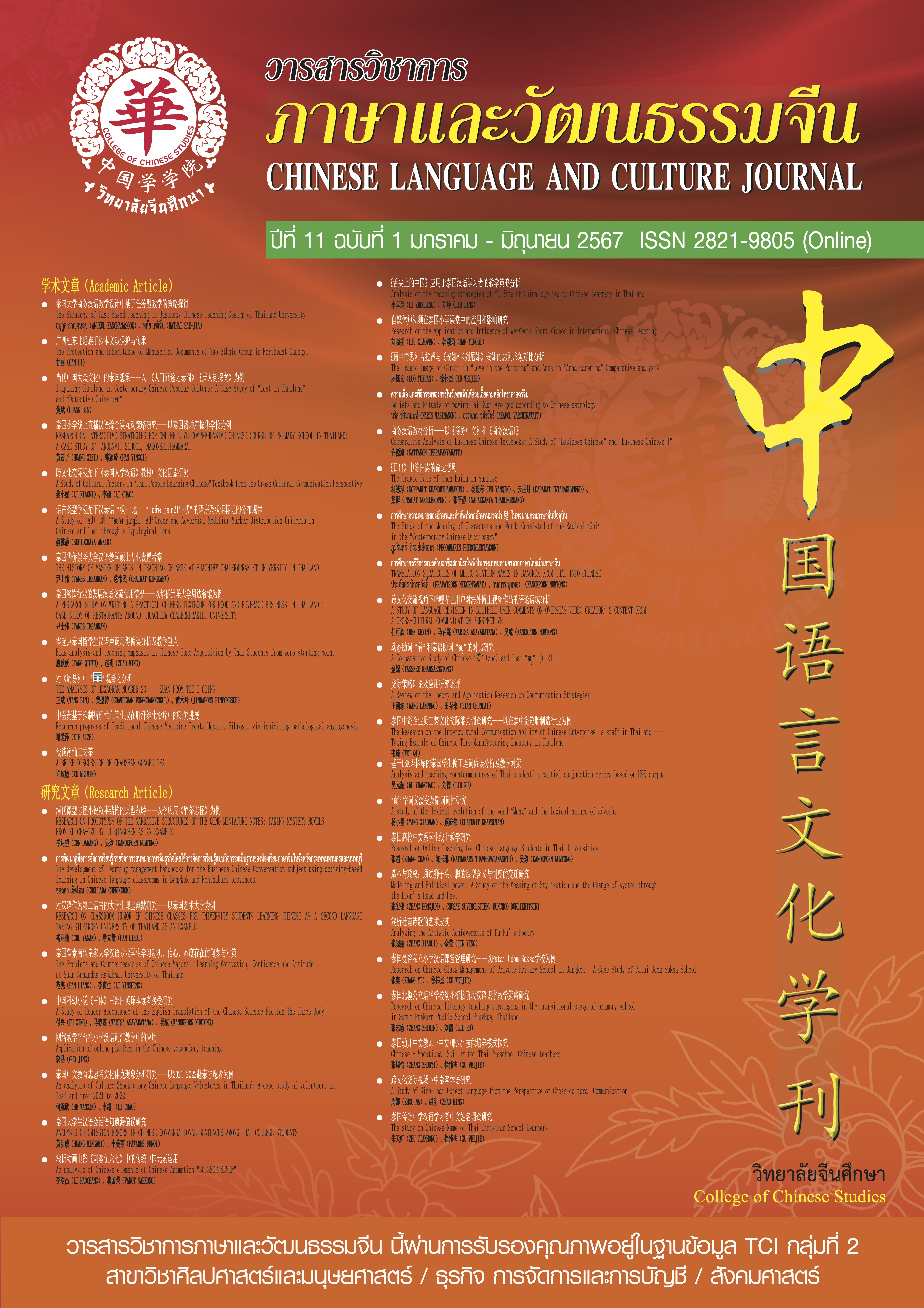RESEARCH ON PROTOTYPES OF THE NARRATIVE STRUCTURES OF THE QING MINIATURE NOTES: TAKING MYSTERY NOVELS FROM ZUICHA-TZU BY LI QINGCHEN AS AN EXAMPLE
Keywords:
Qing Dynasty, Ghostly Note, Mystery Novels from Zuicha-tzu, Mini-novel, Narrative paradigm, Prototype categoryAbstract
Notes(笔记), a novel style particularly for the classic Chinese(文言) writings of short stories, has peaked in the Qing Dynasty(清代) with two pinnacles: Strange Tales from Liaozhai Studio(聊斋志异) and Yuewei Cottage Notes(阅微草堂笔记), each of which employes disparate narrative paradigms towards to their ghost themed stories. The storytelling manner in Liaozhai is more complicated alike the Tang-Romance(唐代传奇) whereas Yuewei takes a rather straight way parallel to the most classic Supernatural Tales of the Six Dynasties(六朝志怪). Among Liaozhai and Yuewei had Night Chronicles(夜谭随录)& Autumn lantern talks(秋灯丛话), etc., and after Yuewei had Ear Feeding Record(耳食录)& Mystery Novels from Zuicha-tzu(醉茶志怪), all of whose writing-styles and novel-volumes had met the criteria of mini-novels. Especially in the chronologically last Mystery Novels from Zuicha-tzu(醉茶志怪), its shorter Notes only have a dozen words, while the word counts of its longer novels exceeds no more than one thousand as well. Acclaimed by its author Li Qichen(李庆辰), the subtle but profound writing style of the Mystery Novels from Zuicha-tzu is a combination of both Liaozhai and Yuewei, knitting characters, backgrounds and plots of the stories closely together just as one piece. Therefore, this paper, conducting the quantitative-qualitative content-analyzing approach examining the ghostly mini-novels most if not all from Mystery Novels from Zuicha-tzu, aims to deconstruct the prototype categories of the narrative paradigms within the Qing min-novels.
References
陈春燕. (2019, 1 18). 鬼神幻想中的欲望书写——晚清小说《醉茶志怪》中的异类恋分析. 明
清小说研究, 261-275.
陈寅恪. (1980). 金明館叢稿: 二編. 上海古籍出版社.
和邦额. (1986). 夜谭随录. 岳麓书社.
纪昀. (1988). 阅微草堂笔记. 天津市古籍书店.
乐钧. (1986). 耳食录. 岳麓书社.
李建武. (2018). 明清小说史话. 社会科学文献出版社.
李庆辰. (1988). 醉茶志怪. 齐鲁书社.
林海清. (2023). 《醉茶志怪》与运河文化. 明清小说研究(04), 70-83.
鲁迅. (1999). 中国小说史略. 天津人民出版社.
鲁迅. (1997). 小说旧闻钞. 齐鲁书社.
鲁迅. (1981). 鲁迅全集第九卷. 人民文学出版社.
鲁迅. (1958). 中国小说的历史的变迁. 香港中流出版社.
蒲松龄. (1981). 聊斋志异: 二十四卷抄本. 齊魯書社.
钱穆. (2004). 灵魂与心. 广西师范大学出版社.
秦冉冉. (2010). 李庆辰及其《醉茶志怪》研究.
干宝. (1985). 搜神记. 浙江古籍出版社.
任莹. (2022). 唐宋时期的经济繁荣与白话语的发展. 阜阳师范大学学报(社会科学版)(01), 59-
王骥德. (1983). 曲律. 湖南人民出版社.
王椷. (1990). 秋灯丛话. 黄河出版社.
王继凡. (1991). 隋唐仙真. 辽宁大学出版社.
王国维. (2018). 宋元戏曲考. 朝华出版社.
吴承学. (2021). 晚明小品研究. 北京大学出版社.
西北师范学院中文系文艺理论教研室. (1985). 简明文学知识辞典. 甘肃人民出版社.
叶城豪. (2018). 《醉茶志怪》在晚清时期的思想价值. 名作欣赏, 125-126.
游国恩. (1963). 中国文学史. 人民文学出版社.
张德建. (2006). 小品盛行与晚明文学权力的下移. 中国文化研究(1), 136-148.
张厚余. (2008). 明清小品文选. 三晋出版社.
Motsch, M. (2008). 中国中短篇叙事文学史: 从古代到近代. 华东师范大学出版社.
Downloads
Published
How to Cite
Issue
Section
License
Copyright (c) 2024 Chinese Language and Culture Journal

This work is licensed under a Creative Commons Attribution-NonCommercial-NoDerivatives 4.0 International License.
บทความที่ได้รับการตีพิมพ์เป็นลิขสิทธิ์ของวารสารภาษาและวัฒนธรรมจีน มหาวิทยาลัยหัวเฉียวเฉลิมพระเกียรติ
บทความใน “วารสารวิชาการภาษาและวัฒนธรรมจีน” เป็นทรรศนะของผู้เขียนโดยเฉพาะ กองบรรณาธิการไม่มีส่วนในความคิดเห็นในข้อเขียนเหล่านั้น




